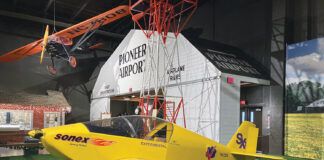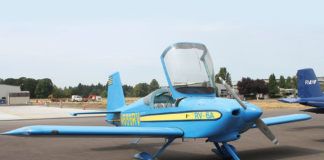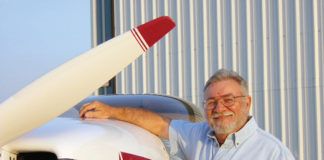Many factors can affect the longitudinal flying qualities of an airplane. Sometimes they can combine to make precise longitudinal control difficult. If the problem is severe enough, the airplane must be modified to improve its longitudinal behavior before it can be considered acceptable for normal operations.
Taming the longitudinal flying qualities of an airplane is not always a simple task because so many different aspects of the configuration can cause the problem. A common mistake is to immediately modify the airplane based on an assumption about what is wrong. Sometimes this works and sometimes it doesn’t. Often, this “throwing darts at the problem” approach works by getting the right answer for the wrong reason.
For example, it is quite common to assume pitch sensitivity is caused by the center of gravity (cg) being too far aft. This assumption leads people to try to fix the problem by ballasting or moving heavy components such as the battery forward to move the cg forward.
If the problem is not primarily cg related, and is really primarily a control-system problem, it will take a large cg movement to do any good, and moving the cg forward might not help at all. Even when such assumption-based efforts are apparently successful, the solution reached is not as good as it could have been if the real problem had been attacked directly. It might not, for example, have been necessary to make the airplane carry the weight of the ballast if another solution to the control difficulties could have been found.
Modifying an airplane inevitably affects more of the machine than it initially appears to. It also affects the entire flight envelope, not just the flight regime where the modification is needed. It is desirable to keep modifications simple and to modify as little as possible to get the needed improvement in flying qualities.
The key to arriving at an effective fix is knowledge.
To fix a problem properly, we must first find out what is really causing the trouble. It is wise to do some technical detective work to isolate the factors that are actually causing the problem before making changes to the airplane. Jumping directly to changing things before doing proper diagnostic tests can lead to furious attempts to cure a disease the patient doesn’t have.
What to Look For
The first goal of a flight-test program to diagnose a longitudinal control problem is to determine if the problem is related to the basic stability of the airplane or to the control system. There are two basic hypotheses we must decide between.
Hypothesis 1: The airplane lacks longitudinal stability. The static margin is too small (or negative), and this lack of stability is what is making the plane difficult to fly.
Hypothesis 2: The control system is giving the pilot poor feedback. Some combination of the elevator-hinge-moment characteristics and the mechanics of the stick and control linkages is causing the feel transmitted from the elevators to the pilot to be unsatisfactory.
Or, both hypotheses are true, and the airplane suffers from both a lack of stability and> a control-system problem.
Assuming that the longitudinal flying qualities of the unmodified airplane are sufficiently manageable that a skilled pilot can fly it safely, flight testing can help pinpoint the cause of the flying-qualities deficiency.
Ideally, the test flights should be performed by an experienced test pilot. If one is not available, then it is wise to prepare yourself carefully before flying the tests.
Flight testing, particularly tests that explore controllability problems, is inherently hazardous. It should be done very carefully, with safety being of primary concern at all times. Remember that you are dealing with an airplane that has some bad habits. Don’t invite it to bite you. A parachute and a way to quickly exit the airplane in an emergency are musts.
Before performing tests in an airplane with a suspected problem, it would be wise to practice them in a well-understood and well-behaved airplane to get some experience performing the tests in a low-risk environment.
During the early diagnostic tests the airplane should be loaded to the forward portion of the cg envelope. Airspeeds should be kept in the middle of the speed range. Don’t get close to the stall, but keep the airspeed well below maximum speed. If anything about the way the airplane is flying begins to feel uncomfortable, unusual, or there is any indication that control might be lost if matters are pressed, don’t push it. Land and think about the problem while sitting safely on the ground.
Make out test cards that call out in detail the test to be performed on any specific flight. Stick to the card and don’t ad lib additional tests. Impromptu additions to a test plan are a common cause of accidents that could have been prevented if the test had been better thought out. It is natural to think, “Thats interesting; what if I try…” during a test, but it can also get you in real trouble if you are nibbling at the edge of a major problem. If something comes to mind while you are airborne, make a note of the idea and add it to a future test card after you have had time to think about how to approach it gradually and safely.
The Tests
There are several tests that explore the longitudinal characteristics of the
airplane. They all give somewhat different information, and more than one will likely be necessary to gain a full understanding of the situation.
This is important: All flight testing for stability requires calm, stable air. If it is even slightly gusty or turbulent, wait for another day. It will be virtually impossible to collect meaningful information in rough air. Repeat all measurements several times to help eliminate errors caused by turbulence or imperfect pilot technique.
Test 1: Stick Force Per G
Stick force per G is one of the dominant parameters affecting longitudinal controllability of an airplane. Accordingly, it is one of the first quantities we should measure to try to characterize the pitch behavior of the airplane.
To perform this test we need to be able to determine the load factor (G level) and stick force in flight. There are two choices for load-factor determination. By far the better choice is a G-meter, which measures load factor directly. If this is not available, then a way of measuring and holding bank angle (i.e., a gyro horizon) will also work. In a constant-altitude turn, the load factor is equal to (1/cosine (bank angle)). See Table 1 (below).
The pilot can set a load factor by flying at a constant bank angle and altitude. This must be done relatively precisely, because the load factor increases quite rapidly as bank angle increases above 60. In fact, 60 is a good bank angle to use in testing for stick force per G because it gives a load factor of exactly 2 G.
Stick force measurements should also be quantitative. If possible, rig up a way to attach a spring scale so that it pulls on the stick at the same point that the pilots hand would grip the stick. If this is not possible, then the pilot must estimate the stick force. A skilled and experienced test pilot can estimate stick force quite accurately, but this is at best an approximate method for most of us.
To measure stick force per G, first trim the airplane in 1-G level flight at constant airspeed. Next, roll the airplane into a turn and stabilize the airspeed, altitude and load factor without retrimming the airplane. Measure and record the stick force and the load factor. To fully characterize the airplane, this test should be performed at several cg positions and airspeeds. Start with the cg at the front of its range and move it aft slowly.
Warning: Aft-cg testing can be risky, particularly if the cg is inadvertently moved back too far. An airplane that is well-mannered and friendly at forward cg can turn nasty when the cg is further aft. Keep the cg increments small, and be alert for any developing controllability problems. If things even begin to get uncomfortable, do not move the cg aft any further.
Do not ever fly the airplane, even for testing purposes, with the cg aft of the aft limit set by the manufacturer or designer. If you do not know the aft cg limit of the airplane, get some technical assistance from someone who can help you determine a safe aft limit. Do not stall the airplane during these tests.
If at any time the airplane requires a push rather than a pull to hold it at a constant load factor higher than 1 G, when trimmed for 1-G flight, this is an indication of instability and potentially dangerous flying qualities. Should this condition appear, keep the load factor down, discontinue the test, and land as soon as possible.
Usually, such a reversed stick force per G gradient indicates that the airplane has a negative (unstable) static margin. In some cases similar behavior can be caused by control surface hinge moment characteristics. In either case, the airplane should not be pushed to a higher load factor, nor should it be flown with the cg further aft than the position at which the reversed stick-force gradient first appeared until the problem has been fully diagnosed.
Data Analysis
Once load factor and stick force have been determined, the stick force per G of the airplane can then be calculated from: Stick force per G = Stick Force/(N-1) where N is the load factor in the turn. The reason the denominator is (N-1) rather than N is that the maneuver started with the airplane trimmed at a load factor of 1.0 (1-G level flight). The stick force measured was the stick force necessary to produce the additional load factor above 1.0.
MIL F-8785C, which is the MIL SPEC for airplane flying qualities, calls out the following as the minimum acceptable stick force per G in maneuvering flight for airplanes with sticks: Min stick force per G = 12/(Nl-1) or 3 pounds per G, whichever is greater; Nl is the limit load factor of the airplane.
For an airplane with a 6-G limit load this criterion gives 4.2 pounds of stick force per G as the minimum acceptable level. The limit for acceptable stick force per G applies to the entire flight envelope of the airplane.
Test 2: Stick Deflection Per G
If the airplane has an acceptable stick force per G, but still feels pitch-sensitive, then the problem may lie in the amount of stick deflection required to maneuver the airplane in pitch. A stick with very little fore and aft movement will feel sensitive even if the force the pilot is exerting to move the elevators is acceptable. The procedure to test for this is similar to the stick-force-per-G test. The only difference is that the change in stick position between the trimmed 1-G case and the stick position in the stabilized turn is the parameter that should be measured.
If the stick movement per G is very small, a change in the stick-to-elevator gearing may help eliminate the sensitive feel. The combination of acceptable stick force per G but unacceptably small stick travel per G is rare in airplanes where the stick is mechanically linked directly to the elevators, because a reasonable amount of stick travel is usually required to keep stick force per G low enough to be acceptable. On airplanes with powered control systems, the relationship between stick travel and elevator deflection can be changed at will, and this problem can occur.
Test 3: Trim Characteristics
The next piece of data we want to get is the relationship between elevator position and trimmed airspeed. To perform this test, we must be able to measure the deflection of the elevator in flight; doing this directly can be difficult. It is much easier to measure stick position instead of elevator position. By measuring elevator and stick position on the ground for a number of deflections, it is possible to convert the stick position data measured in the air to elevator position. Cable stretch and control-system slop may introduce some inaccuracy in translating from stick position to elevator position, but it is not usually serious enough to invalidate the test. It is a good idea to check for control-system slop while taking the stick and elevator position measurements on the ground. If there is enough slop in the control system to seriously affect the accuracy of your conversion of data from stick to elevator position, then there is enough slop to be part of the flying-qualities problem you are chasing.
The test procedure is to trim the airplane in level 1-G flight and record the airspeed and the elevator (or stick) position. Repeat this process for a number of airspeeds, ranging from the normal approach speed of the airplane to cruise speed. The results should be plotted to produce a curve of elevator deflection versus trimmed airspeed. (Note: On an airplane with a trimmable horizontal tail, the position of the trimmable portion of the tail must also be recorded and plotted.) The sign convention for elevator deflections is that a positive elevator deflection is a trailing-edge down deflection. (This seems backward to me, but that is the universally used convention. I have been told that it arises from the fact that deflecting the elevator down adds lift to the control surface, and the sign of a control-surface deflection is determined by how it affects the lift of the surface.)
Two sample trim curves are plotted in Figures 1 and 2. The plot in Figure 1 is for an airplane with a static margin of 10%. This is a comfortably stable airplane. Note that as airspeed increases, the trim elevator deflection becomes more positive (trailing-edge down).
The plot in Figure 2 is for an airplane with a static margin of -5%, which is unstable. The situation we saw for the stable airplane is now reversed. As airspeed increases, the elevator deflection to trim is becoming more negative (trailing-edge up). If the airplane were neutrally stable, we would see little or no change in elevator deflection to trim over a wide range of airspeed.
By performing this test at several cg positions, it is possible to determine where the stick-fixed neutral point of the airplane is. This is the cg at which the airplane is neutrally stable if the pilot holds the stick and does not let the elevators float. In general, the normal operating aft cg limit of an airplane is several percent mean aerodynamic chord (MAC) forward of the neutral point.
Do not try to fly the airplane with the cg at or behind the neutral point. It should be possible to determine the neutral point by extrapolating from data taken with the cg at several stable (more forward) positions.
The value of this test is that it helps us to differentiate between a hinge-moment problem and a static margin problem, and also helps to define the aerodynamic aft cg limit without having to actually fly the airplane with the cg at the aft limit.
If the airplane has a very low stick force per G, but the trim curve shows a strong stable trend in trim elevator deflection as a function of airspeed, then the airplane has enough static margin, and the problem resides in either the hinge-moment characteristics of the elevator or the control linkages.
If, on the other hand, the trim curve shows that there is little change in trim elevator position with airspeed or shows an unstable variation of elevator position with airspeed, then the airplane lacks static margin, and the problem lies in the fact that the cg is not far enough forward of the aerodynamic center (AC) of the airplane. If the airplane has a variable-incidence tailplane for trim, then the curve of tailplane incidence for trim can be used in a similar manner to the elevator trim curve we have just discussed.
Next month, we will discuss some additional tests that can help explore longitudinal flying qualities, and begin a look at how to interpret the data we have gathered.













